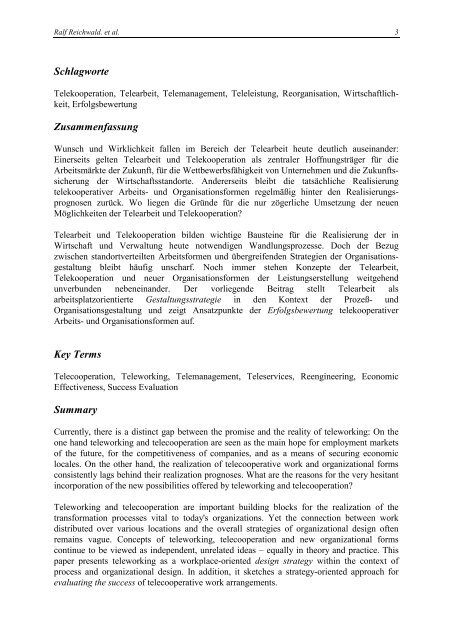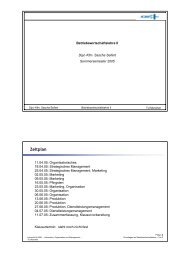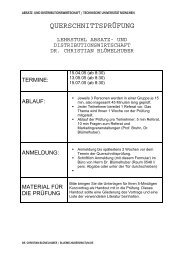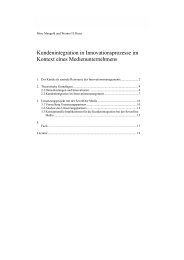Telearbeit & Telekooperation - Lehrstuhl für Allgemeine und ...
Telearbeit & Telekooperation - Lehrstuhl für Allgemeine und ...
Telearbeit & Telekooperation - Lehrstuhl für Allgemeine und ...
Sie wollen auch ein ePaper? Erhöhen Sie die Reichweite Ihrer Titel.
YUMPU macht aus Druck-PDFs automatisch weboptimierte ePaper, die Google liebt.
Ralf Reichwald. et al. 3<br />
Schlagworte<br />
<strong>Telekooperation</strong>, <strong>Telearbeit</strong>, Telemanagement, Teleleistung, Reorganisation, Wirtschaftlichkeit,<br />
Erfolgsbewertung<br />
Zusammenfassung<br />
Wunsch <strong>und</strong> Wirklichkeit fallen im Bereich der <strong>Telearbeit</strong> heute deutlich auseinander:<br />
Einerseits gelten <strong>Telearbeit</strong> <strong>und</strong> <strong>Telekooperation</strong> als zentraler Hoffnungsträger <strong>für</strong> die<br />
Arbeitsmärkte der Zukunft, <strong>für</strong> die Wettbewerbsfähigkeit von Unternehmen <strong>und</strong> die Zukunftssicherung<br />
der Wirtschaftsstandorte. Andererseits bleibt die tatsächliche Realisierung<br />
telekooperativer Arbeits- <strong>und</strong> Organisationsformen regelmäßig hinter den Realisierungsprognosen<br />
zurück. Wo liegen die Gründe <strong>für</strong> die nur zögerliche Umsetzung der neuen<br />
Möglichkeiten der <strong>Telearbeit</strong> <strong>und</strong> <strong>Telekooperation</strong>?<br />
<strong>Telearbeit</strong> <strong>und</strong> <strong>Telekooperation</strong> bilden wichtige Bausteine <strong>für</strong> die Realisierung der in<br />
Wirtschaft <strong>und</strong> Verwaltung heute notwendigen Wandlungsprozesse. Doch der Bezug<br />
zwischen standortverteilten Arbeitsformen <strong>und</strong> übergreifenden Strategien der Organisationsgestaltung<br />
bleibt häufig unscharf. Noch immer stehen Konzepte der <strong>Telearbeit</strong>,<br />
<strong>Telekooperation</strong> <strong>und</strong> neuer Organisationsformen der Leistungserstellung weitgehend<br />
unverb<strong>und</strong>en nebeneinander. Der vorliegende Beitrag stellt <strong>Telearbeit</strong> als<br />
arbeitsplatzorientierte Gestaltungsstrategie in den Kontext der Prozeß- <strong>und</strong><br />
Organisationsgestaltung <strong>und</strong> zeigt Ansatzpunkte der Erfolgsbewertung telekooperativer<br />
Arbeits- <strong>und</strong> Organisationsformen auf.<br />
Key Terms<br />
Telecooperation, Teleworking, Telemanagement, Teleservices, Reengineering, Economic<br />
Effectiveness, Success Evaluation<br />
Summary<br />
Currently, there is a distinct gap between the promise and the reality of teleworking: On the<br />
one hand teleworking and telecooperation are seen as the main hope for employment markets<br />
of the future, for the competitiveness of companies, and as a means of securing economic<br />
locales. On the other hand, the realization of telecooperative work and organizational forms<br />
consistently lags behind their realization prognoses. What are the reasons for the very hesitant<br />
incorporation of the new possibilities offered by teleworking and telecooperation?<br />
Teleworking and telecooperation are important building blocks for the realization of the<br />
transformation processes vital to today's organizations. Yet the connection between work<br />
distributed over various locations and the overall strategies of organizational design often<br />
remains vague. Concepts of teleworking, telecooperation and new organizational forms<br />
continue to be viewed as independent, unrelated ideas – equally in theory and practice. This<br />
paper presents teleworking as a workplace-oriented design strategy within the context of<br />
process and organizational design. In addition, it sketches a strategy-oriented approach for<br />
evaluating the success of telecooperative work arrangements.













